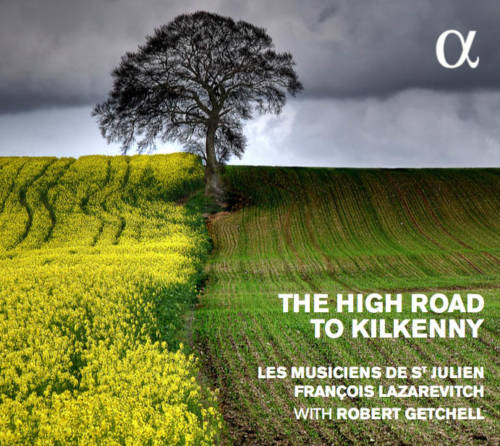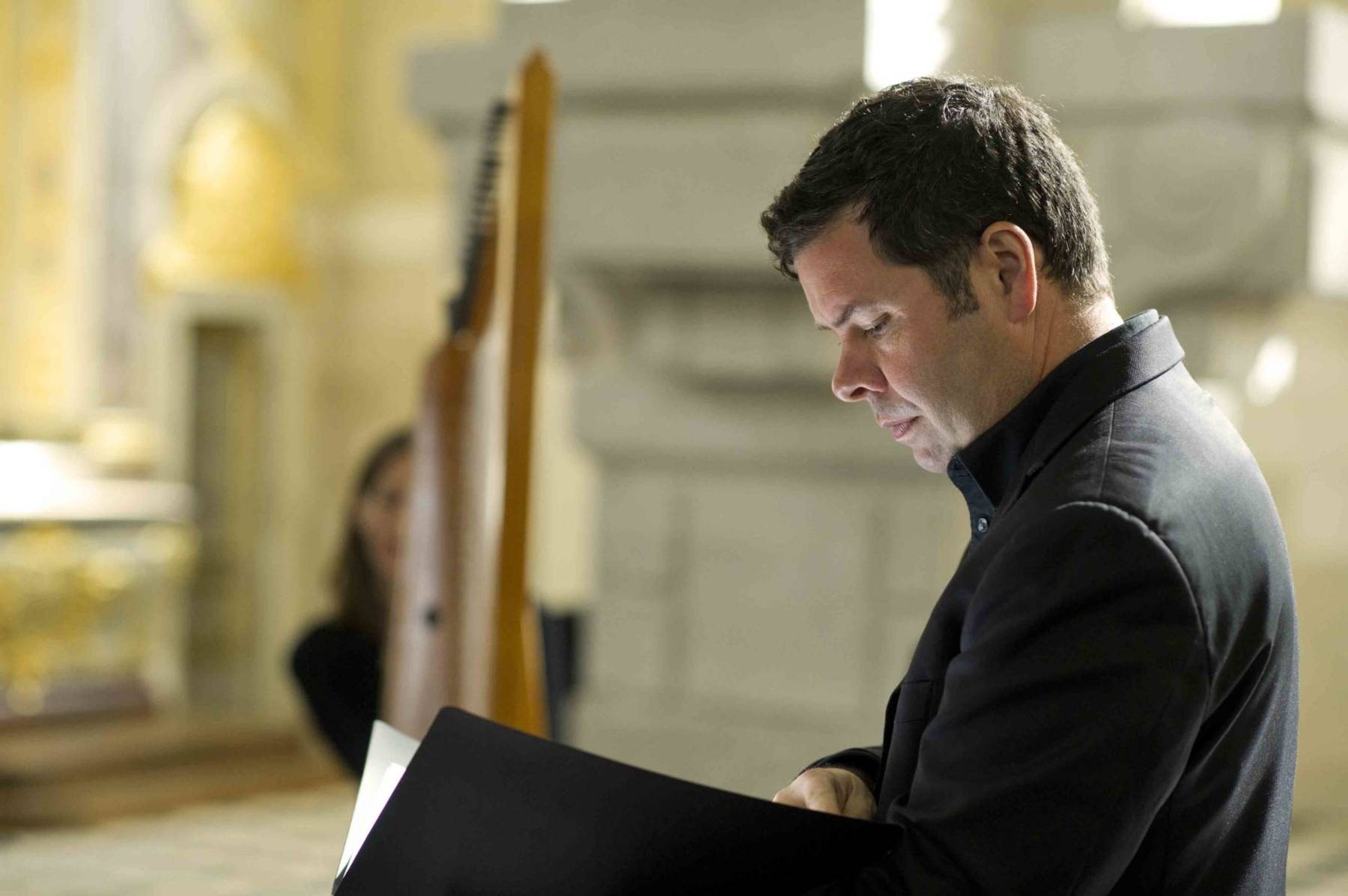The High Road to Kilkenny
Gælic songs and dances of the 17th & 18th centuries

Description
After For Ever Fortune (Alpha Classics, 2010), this second incursion by Les Musiciens de Saint-Julien onto Celtic territory,The High Road to Kilkenny, combines refined, classical pieces alongside an entertaining repertoire of songs in Gælic and dances from the Irish baroque.
Enshrined in a language, dances and emblematic instruments, Irish music also bears in it the mark of an insular pœtry and a turbulent history. This is what this jubilant and enticing programme testifies to, and for which François Lazarevitch has interrogated original texts and collections from the 18th and 19th centuries. A variety of couplets, lullabies, bardic songs and hymns to nature recount and dance the themes of love, infidelity, and the seasons, but also occupation and exile.
Les Musiciens de Saint Julien are inspired by the interpretation of this repertoire today, which is no longer merely ‘picturesque’ and has no fixed codes. The ensemble finds this inspiration in the art of phrasing and ornamentation as it is explained in numerous baroque treatises, the energy and pœtry of period instruments, and the mix of musical traditions and sources. They are at home here at the table of the great Irish names of the 17th and 18th centuries, and once again cross paths with one of their faithful partners: the tenor, Robert Getchell, very much present on the baroqueopera stage and passionate about different kinds of Irish music.
CD available on the Alpha Classics label.
6 to 9 artists
Robert Getchell, tenor
François Lazarevitch, flutes / tin whistle / small-pipes / direction
violin, clàrsach (Irish harp), Baroque harp, viola da gamba, theorbo/cittern, step dancing
Production
Les Musiciens de Saint-Julien, Irish Cultural Center in Paris, created with the support of the Spedidam
Video
The High Road to Kilkenny

 Choc de Classica
Choc de Classica 5/5 De Volkskrant
5/5 De Volkskrant
Alpha Classics • Alpha 234 • ISBN 3760014192340 • 1 CD • 1 h 09
- Oro Mhor a Mhoirin – The Gorum (4:48)
- Sir Ulik Burke (4:43)
- The Drummer (2:39)
- Cuckold come out the Amery (4:14)
- Edward Corcoran (2:36)
- Celia Connallon (3.08)
- Sir Arthur Shæn – Colonel Irwin – Clonmell Lassies – The Scolding Wife (5:12)
- Lord Mayo (6:09)
- Soggarth Shamus O’Finn (3:29)
- When She Cam ben, She Bobbit – Kitty’s Wishes (5:09)
- Do Chuirfinnse Felin Mo Leanbh a chodladh (3:41)
- The Banks of Barrow (3:41)
- James Betagh – Lady Wrixon (4:03)
- O’Neill’s Riding – Barrack Hill – Petrie n°94 – Irish Air (4:12)
- King of the Blind (3:18)
- Molly Mac Alpin (3:24)
- The Cunning Young Man (1:32)
- The High Road to Kilkenny – Toss the Father – The Mill Stream – Money Musk (3:19)
Photos
Programme
Anonyme
Oro Mhor a Mhoirin (chanson) – The Gorum – The Morning Star – The Country Girl’s Fortune (reel)
David Murphy (début XVIIe siècle)
Lord Mayo (chanson)
Anonyme
Soggarth Shamus O’Finn (Lament)
Variations de James Oswald (1710-1769) & Turlough O’Carolan (1670-1738)
When she cam ben, she bobbit – Kitty’s Wishes (reel)
Thomas Connellan (vers 1650)
Celia Connallon (chanson)
Turlough O’Carolan & Neal ms.
Sir Arthur Shaen (Air) – Colonel Irwin – Clonmell Lassies – The scolding wife (reels)
Turlough O’Carolan (1670-1738)
Sir Ulick Burk (chanson) – Edward Corcoran (planxty)
Anonymes
O’Neill’s riding (march) – Barrack hill – Petrie n°94 (slides) – Irish Air
Do Chuirfinnse Féin Mo Leanbh a Chodladh (I would put my own child to sleep) (berceuse)
Anonymes
The Banks of Barrow (Air) Turlough O’Carolan James Betagh – Lady Wrixon (planxty)
John & William Neal (1724)
King of the Blind
Anonyme
The Drummer (chanson)
John Peacock (1756-1817)
Cuckold come out the Amery
Anonymes
The High Road to Kilkenny (slip jig) – Toss the Feathers – The Mill Stream – Money Musk (reels)
Forthcoming events
with this program
Press
june 2018
Ouest France
The High Road to Kilkenny : standing ovation
The stage of the Théâtre de Cornouaille still resonates with them. The musicians of Saint Julien, led by flutist François Lazarévitch, performed Irish music from the 17th to the 19th century on Tuesday at the national theatre. The hall was sold out, and the warm welcome they received was in perfect keeping with the music, which invites you to dance and travel through time and emotion. Presented by the excellent tenor Robert Getchell, the programme was varied and colourful: from dances to love songs and a beautiful lullaby, Do Chuirfinnse Féin Mo Leanbh A Chodladh, sung in Gaelic, each song enchanted an audience that was both enthralled and enthusiastic. Young stepdancer Emily Flack also caused a sensation: her breathtaking precision and talent, and her infectious energy, made these moments of dance veritable pearls of happiness. But it was time to say goodbye. The musicians performed two encores, including the lovely Parting Glass, this time in English, before resuming the pre-programme to a vibrant standing ovation.
may 2018
Ouest France
Embarquement vers The High Road to Kilkenny
Les Musiciens de Saint-Julien will be on the national stage in Quimper on Tuesday. Led by flutist François Lazarevitch, they will be performing the Scottish and Irish baroque repertoire. The Musiciens de Saint- Julien are renowned for their precise work on baroque music from all horizons. After a first album on Scottish baroque music (For Ever Fortune, released in 2012), they are back with a new opus, they are back with a new opus, The High Road to Kilkenny, a collection of early Irish music. When I was studying music, I became interested in Irish and Scottish music, because it moved me and I wanted to explore it further,’ recalls François Lazarevitch. So I went to meet musicians who passed on their music orally. When you want to interpret ancient music, you find treatises and writings that you can’t do without, but you also have to be familiar with dance music and ornamentation and be part of the oral tradition. The artists play period instruments. Audiences will be able to discover the triple harp, or Irish harp, which is a little different from our Celtic harps. Among the instrumentalists is the tehranist Robert Getchell, who will be performing a number of tunes: ‘In the old days, there was a poetry writer, a poet who recited the texts and a harpist. When, in the 17th century, musicians became itinerant, the harpist did everything. So we have chosen, among others, pieces by the best-known harpist, Turlough O’Carolan (1670-1738), who wrote the lyrics himself’. Dancer Emily Flack will also be on stage alongside the musicians. This research into the ancient Irish repertoire has been a long-term project. ‘We had to go to the source and find the scores. Sometimes there was just a melody, sometimes with a bass, and we made the arrangements. Thanks to Edward Bunting (1773-1843), who collected many tunes for harp, we were able to find some music. Eight artists on stage, spellbinding music, an ‘eclectic repertoire, with aristocratic and entertaining music’, adds François Lazarevitch: everyone will be able to discover or rediscover the origins of the Irish music so appreciated in our region, which is so marked by Celtic culture.
may 2018
Le Télégramme
Éliane Faucon-Dumont
The Musiciens de Saint-Julien led the large audience gathered at the Théâtre de Cornouaille on Tuesday evening on ‘The High road to Kilkenny’. Along the way, flutes, smallpipes, fiddle, triple and Irish harps, viola da gamba, archlute and cistre accompanied the virtuoso steps of Emily Flack and the magnificent voice of tenor Robert Getchell. Full of refinement, the music and songs by O Carolan and Thomas Connellan, two famous 17th-century harpists, as well as David Murphy, James Oswald and John Peacock, celebrate Ireland while inviting us to dance. Robert Getchell briefly explains the theme of the songs he performs with great poetry. His tenor voice climbs through the octaves, marrying the elegant sounds of the flute (played by the excellent François Lazarevitch). He sings of disappointed love, the hoped-for voyage, the port where good wine is drunk. Baroque accents The ensemble, with its baroque accents and changing tempos, accompanies his journeys from the North to the South of Ireland, and sometimes his longings for elsewhere. The emotion he arouses is sometimes doubled by a great nostalgia and an impression of an impossible dream. Often at the centre of the orchestra, Emily Flack dances. In a short leather dress and black jumper, she performs the steps that are the hallmark of Ireland. The enthusiastic audience warmly applauded each of her performances. Then the harps join in, just as they did in the past for an intense melody, the flute and strings sometimes entering one by one into a dance tune. Robert Getchell sings in English and Gaelic. ‘Do Chuirfinse Féin Mo Leanbh a Chodaldh’, an anonymous lullaby, is one of the wonders of this concert.









